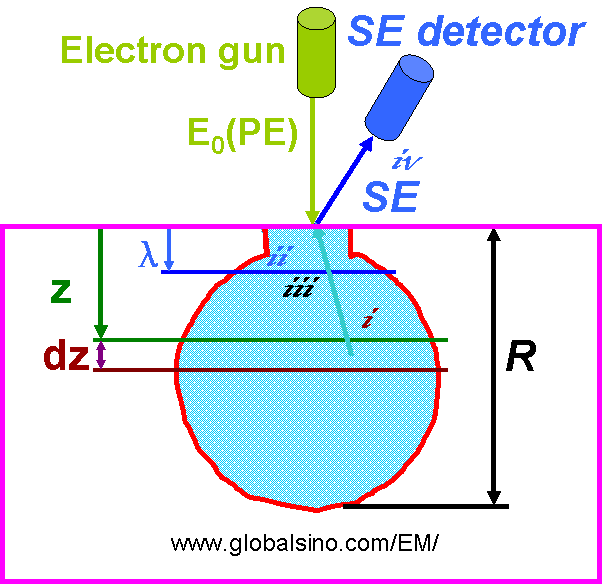=================================================================================
There are mainly four processes which determine secondary electron (SE) emission from a material surface:
i) Electron generation, by the inelastic scattering of primary electrons, within the near surface and bulk of the material. The generation rate is characterized by G.
ii) Random migration of the SEs. These SEs are elastically and/or inelastically scattered by atoms in the specimen and part of the SEs reach the specimen surface (characterized by probability T).
iii) Escape of the SEs over the surface potential barrier [1- 2], characterized by escape probability P.
iv) Recombination and leakage of part of SEs.
Processes i), ii) and iv) strongly depend on the properties of the materials, while process iii) mostly depends on surface properties as shown in Figure 4473.

Figure 4473. Schematic representation of four main processes which determine SE emission.
SE imaging:
Reimer [3] summarized the process of contrast generation in SE images. In SE imaging, process iv) does not contribute to SE imaging signal. However, there is other factor, which controls the SE imaging signal:
v) The emitted SEs are accelerated in vacuum so that a fraction of SEs reachs the electron detector, characterized by D.
Therefore, the SE signal is a product of these four factors, given by,
S = G·T·P·D ----------------------------- [4473a]
Assuming D is equal to 1, the SE yield is given by,
S = G·T·P = S/I0 --------------------------- [4473b]
where,
I0 -- The current of the primary electron beam,
S -- The numbers of SEs.
Note that the escape probability P depends strongly on the depth z where the SE is generated, and becomes small for SEs generated below the escape depth.
[1] Joy DC (1987) J Microsc 147(1):51.
[2] Dionne GF (1973) J Appl Phys 44(12):5361.
[3] L. Reimer, Scanning Electron Microscopy, second edition, Springer, New York,
1998.
|
